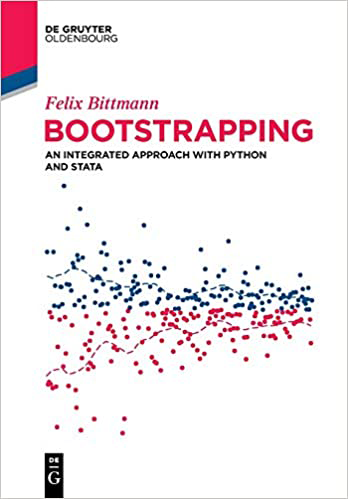

20% off Stata Gift Shop purchases through 12 December
Bootstrapping: An Integrated Approach with Python and Stata |
||||||||||||||||||||||||||||||||
 Click to enlarge |

As an Amazon Associate, StataCorp earns a small referral credit from
qualifying purchases made from affiliate links on our site.
eBook not available for this title
eBook not available for this title |
|
||||||||||||||||||||||||||||||
Comment from the Stata technical groupBootstrapping: An Integrated Approach with Python and Stata, by Felix Bittmann, is a great resource for students and researchers who want to learn and apply bootstrap methods. The text begins with a clear introduction to foundational statistics on which bootstrapping methods rely. Bittmann then walks users through the logic behind bootstrapping as well as the process. The book includes discussion of confidence intervals and hypothisis testing as well as a chapter focused on bootstrap considerations related to regression models. The final chapter demonstrates how researchers can perform bootstrapping using Stata and Python. Examples range from straightforward use of Stata's bootstrap prefix and vce(bootstrap) option to more advanced techniques such as writing a program for resampling residuals. With this knowledge, readers will be ready to apply bootstrapping in their own analyses using Stata. |
||||||||||||||||||||||||||||||||
Table of contentsView table of contents >> Introduction
1. Basic statistical concepts
1.1 Arithmetic mean
1.2 Standard deviation 1.3 Standard error 1.4 Confidence intervals 1.5 Applied example 1.6 P-values 1.7 Testing for normality 1.8 Probability density functions 1.9 Bias and variance 1.10 Normality and confidence intervals revisited 2. Bootstrapping
2.1 Working example
2.2 Requirements 2.3 Diagnostics 2.3.1 Unique values 2.3.2 Distribution of bootstrap-results 2.3.3 Rate of convergence 2.4 The logic of bootstrapping 2.5 Failures of the bootstrap 3. Confidence intervals
3.1 Normal intervals
3.2 Percentile intervals 3.3 Bias corrected intervals (BC) 3.4 Bias corrected and accelerated intervals (BCa) 3.5 Double bootstrap 3.6 Transformations 3.7 Summary and simulation 4. Hypothesis testing
4.1 The logic of hypothesis tests
4.2 Confidence intervals 4.3 Sampling in accordance with the null 4.4 Permutation tests 4.4.1 Paired permutation tests 4.4.2 Boot or permute? 4.5 Power calculations 5. Regression models
5.1 Sampling observations
5.2 Sampling residuals 5.3 Dealing with outliers 5.4 Predicting outcomes and bagging 6. Applied programming examples
6.1 Python
6.1.1 Basics 6.1.2 All confidence intervals 6.1.3 Permutation tests 6.1.4 Multithreading 6.1.5 Importing data 6.1.6 Appendix 6.2 Stata 6.2.1 Descriptive statistics 6.2.2 Estimating models 6.2.3 Writing own programs 6.2.4 Permutation tests 6.2.5 Longitudinal and cluster analyses 6.3 Computational speed 6.4 Further reading Bibliography
|
||||||||||||||||||||||||||||||||
Learn
Free webinars
NetCourses
Classroom and web training
Organizational training
Video tutorials
Third-party courses
Web resources
Teaching with Stata
© Copyright 1996–2025 StataCorp LLC. All rights reserved.
×
We use cookies to ensure that we give you the best experience on our website—to enhance site navigation, to analyze usage, and to assist in our marketing efforts. By continuing to use our site, you consent to the storing of cookies on your device and agree to delivery of content, including web fonts and JavaScript, from third party web services.
Cookie Settings
Last updated: 16 November 2022
StataCorp LLC (StataCorp) strives to provide our users with exceptional products and services. To do so, we must collect personal information from you. This information is necessary to conduct business with our existing and potential customers. We collect and use this information only where we may legally do so. This policy explains what personal information we collect, how we use it, and what rights you have to that information.
These cookies are essential for our website to function and do not store any personally identifiable information. These cookies cannot be disabled.
This website uses cookies to provide you with a better user experience. A cookie is a small piece of data our website stores on a site visitor's hard drive and accesses each time you visit so we can improve your access to our site, better understand how you use our site, and serve you content that may be of interest to you. For instance, we store a cookie when you log in to our shopping cart so that we can maintain your shopping cart should you not complete checkout. These cookies do not directly store your personal information, but they do support the ability to uniquely identify your internet browser and device.
Please note: Clearing your browser cookies at any time will undo preferences saved here. The option selected here will apply only to the device you are currently using.